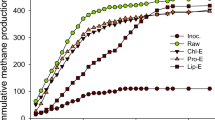Abstract
CO2-induced climate change drives the development of renewable processes for industrial products. Algae processes can actively fix and convert CO2 into value adding products, such as oils. Algae lipids hence counteract climate change and provide access to renewable commodities. In this context, valorization of algal residues remaining after oil extraction is a challenge for the emerging cyclic bioeconomy. This study focuses on the valorization of oil-extracted algae residues derived from the halophilic strain Scenedesmus obliquus via anaerobic digestion. We examined the effect of prior oil extraction on microbial digestibility and increasing salt content in the substrate with regard to biogas yield and composition. Our cumulative data demonstrate that the supercritical CO2 oil extraction acts as a physical pretreatment that facilitates enhanced hydrolysis of both polymeric call wall carbohydrates and cellular proteins, providing methane yields of 213.2 LN kg−1 VS day−1. Methane yields were 20% higher than literature values obtained with the same algae strain in the absence of prior oil extraction. We obtained these superior results albeit all lipids and nonpolar proteins had been extracted from the biogas substrate. Our data indicate that continuous anaerobic digestion without loss of fermentation efficiency is feasible up to a salt concentration of 2% w/v, if conventional, agricultural biogas plants are gradually adapted to the salt content of the substrate. Monofermentation of the investigated oil-extracted algae residue is technically feasible at loading rates of 1.5 kg VS m−3 day−1, but a supplementation with carbohydrate rich biomass would prove beneficial to alleviate ammonia inhibition.





Similar content being viewed by others
References
Bellou S, Baeshen MN, Elazzazy AM et al (2014) Microalgal lipids biochemistry and biotechnological perspectives. Biotechnol Adv 32(8):1476–1493. https://doi.org/10.1016/j.biotechadv.2014.10.003
Esakkimuthu S, Krishnamurthy V, Govindarajan R et al (2016) Augmentation and starvation of calcium, magnesium, phosphate on lipid production of Scenedesmus obliquus. Biomass Bioenergy 88:126–134. https://doi.org/10.1016/j.biombioe.2016.03.019
Gallego R, Montero L, Cifuentes A et al (2018) Green extraction of bioactive compounds from microalgae. J Anal Test 2(2):109–123. https://doi.org/10.1007/s41664-018-0061-9
Richardson J, Johnson M, Joe L (2012) Economic comparison of open pond raceways to photo bio-reactors for profitable production of algae for transportation fuels in the Southwest. Algal Res. https://doi.org/10.1016/j.algal.2012.04.001
Mooij PR, Stouten GR, van Loosdrecht MCM et al (2015) Ecology-based selective environments as solution to contamination in microalgal cultivation. Curr Opin Biotechnol 33:46–51. https://doi.org/10.1016/j.copbio.2014.11.001
Lorenzen J, Igl N, Tippelt M et al (2017) Extraction of microalgae derived lipids with supercritical carbon dioxide in an industrial relevant pilot plant. Bioprocess Biosyst Eng 40(6):911–918. https://doi.org/10.1007/s00449-017-1755-5
Adamietz T, Jurkowski W, Adolph J, Brück T (2019) Batch and continuous biogas fermentation of the fresh water algae chlorella vulgaris-detailed process analysis. J Bioprocess Biotech 8(5):1–8. https://doi.org/10.4172/2155-9821.1000338
Ogata Y, Ishigaki T, Nakagawa M et al (2016) Effect of increasing salinity on biogas production in waste landfills with leachate recirculation: a lab-scale model study. Biotechnol Rep 10:111–116. https://doi.org/10.1016/j.btre.2016.04.004
Gebauer R (2004) Mesophilic anaerobic treatment of sludge from saline fish farm effluents with biogas production. Biores Technol 93(2):155–167. https://doi.org/10.1016/j.biortech.2003.10.024
Anwar N, Wang W, Zhang J et al (2016) Effect of sodium salt on anaerobic digestion of kitchen waste. Water Sci Technol 73(8):1865–1871. https://doi.org/10.2166/wst.2016.035
Jayathilakan K, Sultana K, Radhakrishna K et al (2012) Utilization of byproducts and waste materials from meat, poultry and fish processing industries: a review. J Food Sci Technol 49(3):278–293. https://doi.org/10.1007/s13197-011-0290-7
Zeb I, Ma J, Mehboob F et al (2019) Kinetic and microbial analysis of methane production from dairy wastewater anaerobic digester under ammonia and salinity stresses. J Clean Prod 219:797–808. https://doi.org/10.1016/j.jclepro.2019.01.295
Lee DH, Behera SK, Kim JW et al (2009) Methane production potential of leachate generated from Korean food waste recycling facilities: a lab-scale study. Waste Manag 29(2):876–882. https://doi.org/10.1016/j.wasman.2008.06.033
de Vrieze J, Coma M, Debeuckelaere M et al (2016) High salinity in molasses wastewaters shifts anaerobic digestion to carboxylate production. Water Res 98:293–301. https://doi.org/10.1016/j.watres.2016.04.035
de Baere LA, Devocht M, van Assche P et al (1984) Influence of high NaCl and NH4Cl salt levels on methanogenic associations. Water Res 18(5):543–548. https://doi.org/10.1016/0043-1354(84)90201-X
Feijoo G, Soto M, Méndez R et al (1995) Sodium inhibition in the anaerobic digestion process: antagonism and adaptation phenomena. Enzyme Microb Technol 17(2):180–188. https://doi.org/10.1016/0141-0229(94)00011-F
Mussgnug JH, Klassen V, Schlüter A et al (2010) Microalgae as substrates for fermentative biogas production in a combined biorefinery concept. J Biotechnol 150(1):51–56. https://doi.org/10.1016/j.jbiotec.2010.07.030
Weiland P (2010) Biogas production: current state and perspectives. Appl Microbiol Biotechnol 85(4):849–860. https://doi.org/10.1007/s00253-009-2246-7
Micolucci F, Gottardo M, Bolzonella D et al (2014) Automatic process control for stable bio-hythane production in two-phase thermophilic anaerobic digestion of food waste. Int J Hydrogen Energy 39(31):17563–17572. https://doi.org/10.1016/j.ijhydene.2014.08.136
Klein R, Slaný V, Krčálová E (2018) Conductivity measurement for control of a biogas plant. Acta Univ Agric Silvic Mendelianae Brun 66(5):1151–1156. https://doi.org/10.11118/actaun201866051151
Yenigün O, Demirel B (2013) Ammonia inhibition in anaerobic digestion: a review. Process Biochem 48(5–6):901–911. https://doi.org/10.1016/j.procbio.2013.04.012
Ozalp G, Gomec CY, Ozturk I et al (2004) Effect of high salinity on anaerobic treatment of low strength effluents. Water Sci Technol 48(11–12):207–212. https://doi.org/10.2166/wst.2004.0842
Miura T, Kita A, Okamura Y et al (2014) Evaluation of marine sediments as microbial sources for methane production from brown algae under high salinity. Biores Technol 169:362–366. https://doi.org/10.1016/j.biortech.2014.07.013
Biogas Forum (2019) https://www.alb-bayern.de/De/themen-aktuelles_Home
Barka A, Blecker C (2016) Microalgae as a potential source of single-cell proteins. A review. Biotechnol Agron Soc Environ 20(3):427–436
Author information
Authors and Affiliations
Corresponding author
Ethics declarations
Conflict of interest
The authors declare no conflict of interest.
Additional information
Publisher's Note
Springer Nature remains neutral with regard to jurisdictional claims in published maps and institutional affiliations.
Rights and permissions
About this article
Cite this article
Adamietz, T., Jurkowski, W., Adolph, J. et al. Biogas yields and composition from oil-extracted halophilic algae residues in conventional biogas plants operated at high salinities. Bioprocess Biosyst Eng 42, 1915–1922 (2019). https://doi.org/10.1007/s00449-019-02185-8
Received:
Accepted:
Published:
Issue Date:
DOI: https://doi.org/10.1007/s00449-019-02185-8




